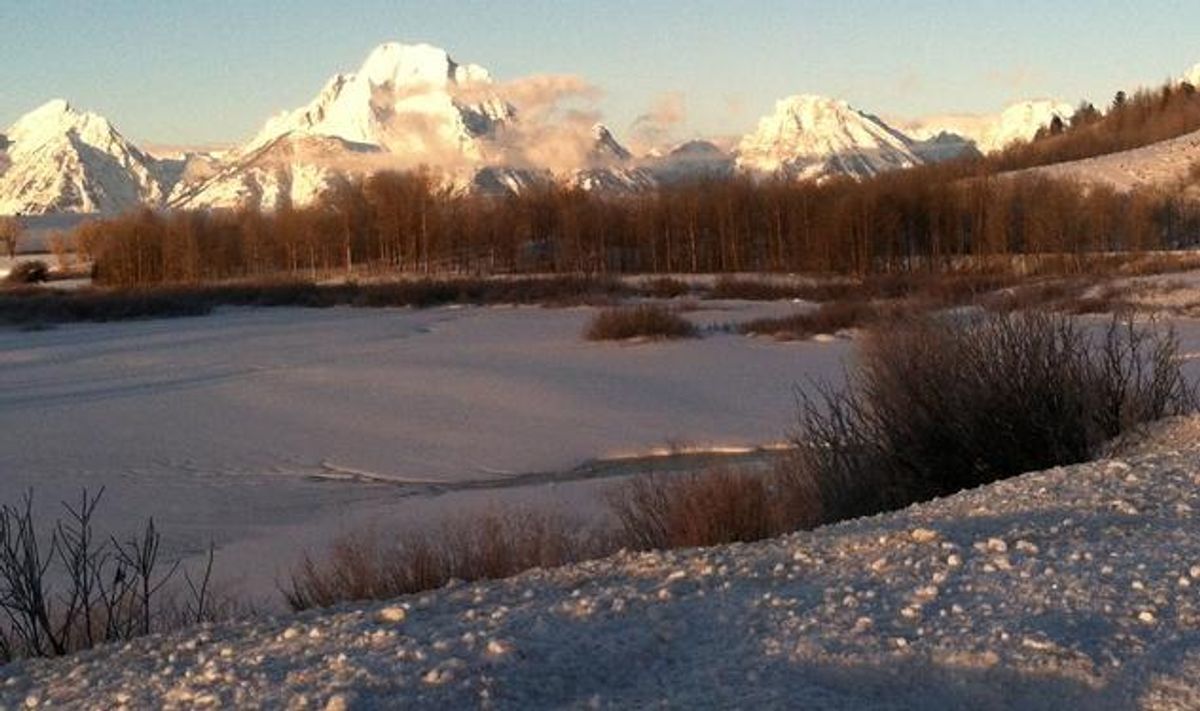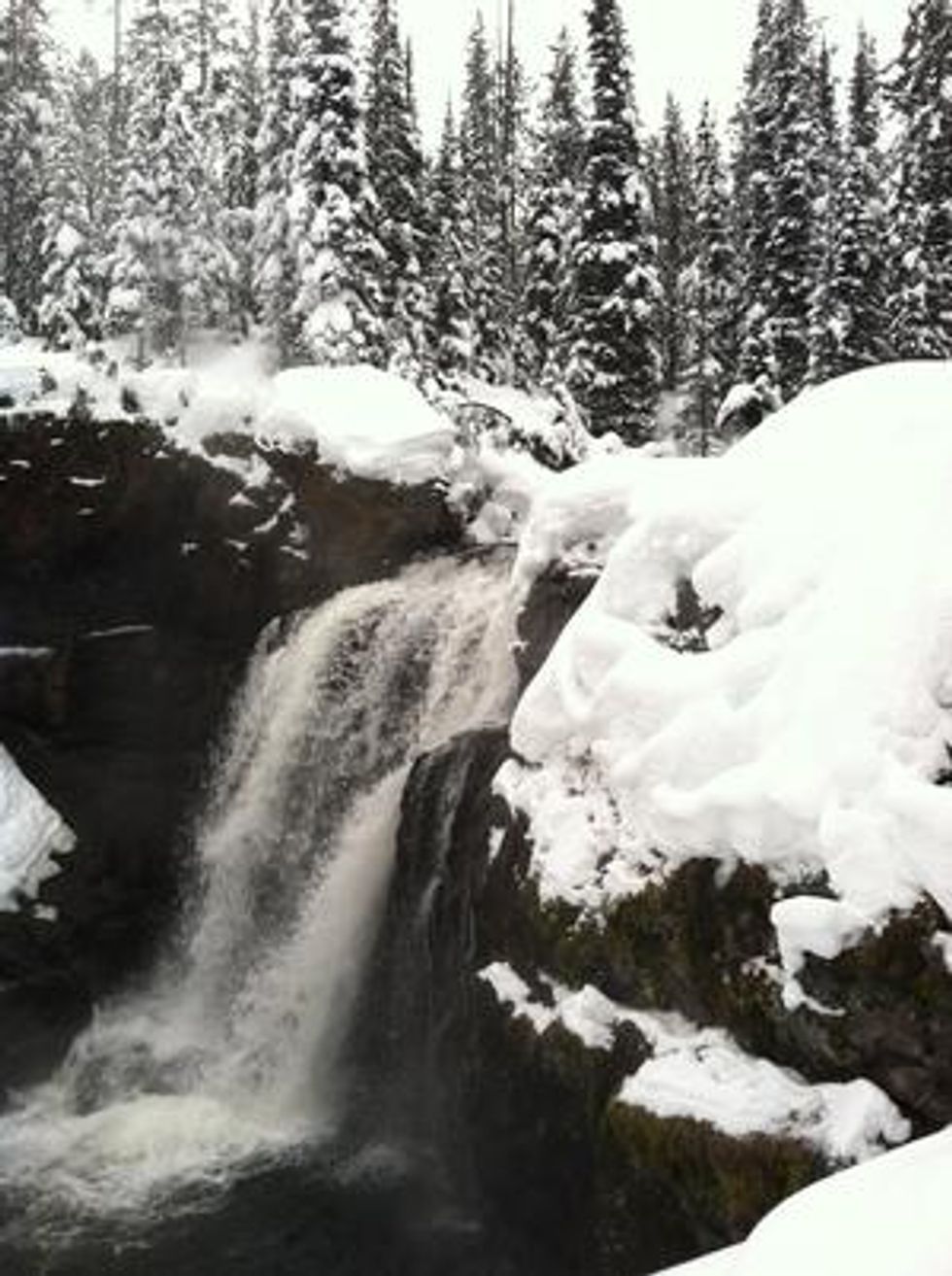Travel & Nightlife
Rocky Mountain, Brights and Darks

Eight months after giving up booze, the writer finds himself in his innocence's final frontier.
March 18 2013 11:37 PM EST
May 26 2023 1:58 PM EST
By continuing to use our site, you agree to our Private Policy and Terms of Use.

Photography by Andrew Belonsky.
I sat next to Stephen Price at dinner my first night in Jackson Hole. He owns Spring Creek Ranch, the resort that hosted a trio of journalists sent to experience a Wyoming winter, and I feared he'd spend the next few hours force feeding me a sales pitch. Instead, he spent most of the meal telling me about himself and his family.
Born in New Jersey to a school teacher mother and a father who sold millworks around New England, Price moved to Jackson Hole in 1990 and today, at 57, looks like Tom Skerritt's ruddier, gaunter younger brother, only with a bushier moustache. He has four children, including two 11-year-old sons adopted from Russia and a 4-year-old daughter; he admits to having a temper and he told me he once attended the same GOP fundraiser as Dick Cheney, one of the varied celebrities who have homes in this red state. Flaming liberal Harrison Ford is another.
Price is the youngest of three brothers, the eldest of whom was named Jonathan. In 1971, the year after he graduated from Georgetown University, Jonathan Price moved to Europe and eventually settled in what was then West Germany. It was while there that he came out to his family in 1984, fell in love and later found out that he was HIV positive. In 1991, Jonathan came to visit his brother in Jackson Hole. Local reaction to an HIV positive person was mixed. "It was a difficult time," says Price. "It was a time when people did not know much about AIDS. Some folks kept their distance, but others stepped right up. One in particular, an old timer wrangler, after I had told him my brother has AIDS, said, 'Stephen, people are people and we are going to make sure your brother has a good visit with you.'" A great time was had by all, says Price. Jonathan died one year later. He was 42.
Stephen teared up, "I still believe Jonathan and the others are out there, in the sky, so do me a favor: when you get back to your room, look up at the sky and look at the stars -- because I can't." The brusque, weather-worn and vividly masculine man stopped before he straight up started crying.
Wyoming's made of moments like this: ones unexpected and contradictory and grim and beautiful all at once. Game reserves set aside to shelter deer and elk dispatch hunters to clear out populations swelled and bloated by government-provided feed. The Grand Teton Mountain Range, byproducts of savage tectonic thrusts, get their grace from their jagged edges. Like a rose's thorn, these protrusions will draw blood. (In 1996, a secret service plane sent ahead to prepare President Clinton's 50th birthday in Jackson Hole crashed into the side of a mountain quaintly referred to as Sleeping Indian. Nine people were killed.)

Wind whips mercilessly and evergreens labor under hefty snowfall while deciduous cousins like the cottonwood stand frozen, appearing empty and incapable of life. But there's no stink of death here. Mule deer, with their white, coquettish tush, hop and trot about the valley as massive moose search for shrubs under snow fields made blindingly bright by the winter sun. Trumpet swans churn up muck in shallow rivers and big horn sheep give us the stink eye from craggy peaks, looking away only when a golden eagle swoops through the crisp, biting cold.
A massive creature with an up to seven foot wing span, the golden eagle has no qualms about taking on the larger, heavier sheep. The clever bird snatches the unlucky beast in its talons and drops them to the rocks below, letting gravity do the dirty work. They're far bolder and stronger than the more famous bird we saw gliding nearby, the bald eagle. Our national mascot has such a wimpy screech that Hollywood replaces it with the more robust and fearsome caw of the red tail hawk, and it's a scavenger, not a hunter (a taker, not a doer), which makes it's revered status even more incomprehensible. Maybe we should all take our cue from the playful river otter. He's adorable and has a great sense of humor. He lets a hungry red fox get within striking distance and then dive into the frozen river, popping up a few yards away -- laughing as he bites into some freshly caught fish.
Vast swaths of the Northern Wyoming tree line are still scorched from the great wild fires of 1988. Though new trees are slowly coming into their own, charred detritus dominate much of the horizon in and around Grand Teton and Yellowstone Parks. The majority of the fires were caused by lightning, but the largest, the one that burned 504,025 acres, was caused by a cigarette. I remember the startling contrast of dead, ghostly shells and flourishing newcomers from when I first visited Yellowstone as in the summer of 1997, only a few months before I myself became a smoker. I was nearly sixteen years old and on a five-week tour of the region with my Minnesota-based summer camp. In addition to taking up smoking, I would soon take up drink and drugs, kicking off a nearly 15-year career of substance abuse that ended almost 8 months to the day of my return to Yellowstone this past January. I was and am still very much in recovery.

Like my addiction, my sexuality remained dormant in 1997. I wouldn't become fully aware of and act upon my attraction to men until the following year. So that summer of 1997 I had no inkling that President Clinton had signed the Defense of Marriage Act, nor did I pay much mind one year later, when Matthew Shepard was murdered in Laramie, about six hours south of Jackson Hole.
The city now hosts an annual Shepard Symposium on Social Justice that includes a performance by Elton John and a reading of Annie Proulx's Brokeback Mountain. That story, published almost exactly one year before Shepard's death, also ends with a senseless anti-gay murder in Wyoming.
This year alone the Wyoming House has just rejected two bills that would have allowed domestic partnerships and same-sex marriages and the state Senate voted against a measure that would have prohibited discrimination based on sexual orientation or gender identity. And despite being the epicenter for the national debate about hate crimes, Wyoming was one of the five states not to have their own hate crimes legislation in place when President Obama signed the 2009 Matthew Shepard and James Byrd, Jr. Hate Crimes Prevention Act into federal law. You can allow yourself an unapologetic chuckle over the juxtaposition of Wyoming's two most popular nicknames, the touchy-feely "Equality State" and the rootin', tootin' " Cowboy State."
Old Faithful's visitor's center looks like a mega church devoted to nature. Its raked peak, designed to repel heavy snow, resembles a steeple and massive windows emit a soft, white light, radiating an orchestrated serenity typically reserved for places of worship. This is an aesthetic apropos for the building's deity, Old Faithful, a natural mecca that attracts about 30,000 visitors each summer. There are only four of us there this January night. We're led past the center/shrine and toward the actual geyser, back in the blackness by Kurt Johnson, Spring Creek's resident naturalist and the author of the 2013 Field Guide to Yellowstone and Grand Teton National Parks.
Like Price, Johnson moved to Jackson Hole from back east, in his case Northern Virginia. Both of his parents were teachers and Johnson, 40, inherited their talent for and love of sharing knowledge. He's a thoughtful, gentle man with deep blue eyes and a dry but accessible sense of humor. He swears more gullible city slickers believe him when he deadpans that an animal track belongs to a rabid, blood-thirsty coyote. As we approach Old Faithful, I mutter something obvious about the attraction's ejaculative qualities lending themselves to virile masculinity. Johnson considers my remark for a moment and replies, "I don't think Old Faithful has a gender identity."

We head to Yellowstone Lake, a massive basin that sits at 7,732 feet atop the continental divide, placement that gives Yellowstone Lake some queer properties. Water on the West flows east, eventually meeting up with the Mississippi River and the Gulf of Mexico, while water on the East flows toward the placid Pacific.
Frozen over in the winter, the only sign that there is even a lake there is the break in the tree line, where only a massive, 136-square mile snow field practically begs for the making of snow angels. I happily comply, even though my muscles are sore from the night before. Prior to our rendezvous with Old Faithful, a few of us decided to check out the modest ice rink at Snow Lodge, the only one of Yellowstone's resorts to stay open in the winter. Our go-round on the ice was a big moment for this writer. I've never ice skated, mostly for fear of falling and having my fingers sliced off by a passerby's blades. But I'm learning not to live in fear, so decided to give it a go, and it was a rough one. I'm tall, gangly and all limbs. My center of gravity's far too high for anything resembling grace on ice. And I wasn't entirely free of fear, but I did it, and I'm told I did very well when skating toward the rink's exit.
Later, as we head out of the park, I gaze again at the tree line, seeing not only the burnt husks but the burgeoning trees, the determined upstarted growing into the space eviscerated 25 years ago and I remember something Kurt the naturalist said. It seems like common sense now, but no one knew at the time that those Wyoming wild fires of 1988 helped save the forests. The old growth had to be cleared out for the new. It's in part because of that fire that national parks now have controlled burns. Incineration is essential for survival. Without that volcanic eruption 640,000 years ago, there would be no Yellowstone, no land for the mule deer and otters and you and me.
On my last night in Wyoming, back at the Spring Creek Ranch, I took a short stroll under the stars. I wanted to see them one final time before heading back to New York City, where they're endangered. Orion and his belt were up there, and so were the dippers, big and little. And if my rudimentary astronomy can be trusted, I saw Gemini. Or one of half-of it, at least. I felt lost in it all, so small and insignificant: the emotions appropriate for staring into such an abyss. Then, in another part of the expansive sky, a strange star caught my eye. Did it flicker with recognition? I don't think so, no, but it made me think about how thankful I am to know nightfall. Without darkness, there would be no stars at all.